- UK release date:
- Mar 22, 1963
- Publisher:
- Parlophone
Timeline
More from year 1963
Related sessions
This album has been recorded during the following studio sessions
The Beatles’ third Abbey Road recording session
Sep 11, 1962
Nov 26, 1962
Mixing "Please Please Me" and "Ask Me Why"
Nov 30, 1962
"Please Please Me" album session #1
Feb 11, 1963
"Please Please Me" album session #2
Feb 20, 1963
"Please Please Me" album session #3
Feb 25, 1963
Spread the love! If you like what you are seeing, share it on social networks and let others know about The Paul McCartney Project.
Hide track details
Track list
Side 1
1.
2:55 • Studio version • A • Mono
- Paul McCartney :
- Bass, Handclaps, Vocals
- Ringo Starr :
- Drums, Handclaps
- John Lennon :
- Backing vocals, Handclaps, Rhythm guitar
- George Harrison :
- Handclaps, Lead guitar
- George Martin :
- Producer
- Norman Smith :
- Recording engineer
- A.B. Lincoln :
- Second engineer
- Session Recording:
- Feb 11, 1963
- Studio :
- EMI Studios, Studio Two, Abbey Road
- Session Mixing:
- Feb 25, 1963
- Studio :
- EMI Studios, Studio One, Abbey Road
2.
1:49 • Studio version • A • Mono
- Paul McCartney :
- Bass, Vocals
- Ringo Starr :
- Drums
- John Lennon :
- Rhythm guitar, Vocals
- George Harrison :
- Lead guitar
- George Martin :
- Piano, Producer
- Geoff Emerick :
- Second engineer
- Norman Smith :
- Recording engineer
- Stuart Eltham :
- Recording engineer
- A.B. Lincoln :
- Second engineer
- Session Recording:
- Feb 11, 1963
- Studio :
- EMI Studios, Studio Two, Abbey Road
- Session Overdubs:
- Feb 20, 1963
- Studio :
- EMI Studios, Studio One, Abbey Road
- Session Mixing:
- Feb 25, 1963
- Studio :
- EMI Studios, Studio One, Abbey Road
3.
Written by Arthur Alexander
2:55 • Studio version • A • Mono
- Paul McCartney :
- Backing vocals, Bass
- Ringo Starr :
- Drums
- John Lennon :
- Acoustic rhythm guitar, Vocals
- George Harrison :
- Backing vocals, Lead guitar
- George Martin :
- Producer
- Norman Smith :
- Recording engineer
- A.B. Lincoln :
- Second engineer
- Session Recording:
- Feb 11, 1963
- Studio :
- EMI Studios, Studio Two, Abbey Road
- Session Mixing:
- Feb 25, 1963
- Studio :
- EMI Studios, Studio One, Abbey Road
4.
Written by Gerry Goffin, Carole King
2:23 • Studio version • A • Mono
- Paul McCartney :
- Bass, Vocals
- Ringo Starr :
- Drums
- John Lennon :
- Harmonica, Rhythm guitar, Vocals
- George Harrison :
- Lead guitar, Vocals
- George Martin :
- Producer
- Norman Smith :
- Recording engineer
- A.B. Lincoln :
- Second engineer
- Session Recording:
- Feb 11, 1963
- Studio :
- EMI Studios, Studio Two, Abbey Road
- Session Mixing:
- Feb 25, 1963
- Studio :
- EMI Studios, Studio One, Abbey Road
5.
Written by Luther Dixon, Wes Farrell
2:24 • Studio version • A • Mono
- Paul McCartney :
- Backing vocals, Bass
- Ringo Starr :
- Drums, Vocals
- John Lennon :
- Backing vocals, Rhythm guitar
- George Harrison :
- Backing vocals, Lead guitar
- George Martin :
- Producer
- Norman Smith :
- Recording engineer
- A.B. Lincoln :
- Second engineer
- Session Recording:
- Feb 11, 1963
- Studio :
- EMI Studios, Studio Two, Abbey Road
- Session Mixing:
- Feb 25, 1963
- Studio :
- EMI Studios, Studio One, Abbey Road
6.
2:24 • Studio version • B • Mono
- Paul McCartney :
- Backing vocals, Bass
- Ringo Starr :
- Drums
- John Lennon :
- Rhythm guitar, Vocals
- George Harrison :
- Backing vocals, Lead guitar
- George Martin :
- Producer
- Norman Smith :
- Recording engineer
- Session Recording:
- Nov 26, 1962
- Studio :
- EMI Studios, Studio Two, Abbey Road
- Session Mixing:
- Nov 30, 1962
- Studio :
- EMI Studios, Studio Two, Abbey Road
7.
2:00 • Studio version • A • Mono
- Paul McCartney :
- Bass, Harmony vocals
- Ringo Starr :
- Drums
- John Lennon :
- Harmonica, Lead vocals, Rhythm guitar
- George Harrison :
- Harmony vocals, Lead guitar
- George Martin :
- Producer
- Norman Smith :
- Recording engineer
- Session Recording:
- Nov 26, 1962
- Studio :
- EMI Studios, Studio Two, Abbey Road
- Session Mixing:
- Nov 30, 1962
- Studio :
- EMI Studios, Studio Two, Abbey Road
Side 2
1.
2:23 • Studio version • B • Mono
- Paul McCartney :
- Bass, Vocals
- Ringo Starr :
- Tambourine
- John Lennon :
- Acoustic rhythm guitar, Harmonica, Vocals
- George Harrison :
- Acoustic rhythm guitar
- George Martin :
- Producer
- Norman Smith :
- Recording engineer
- Andy White :
- Drums
- Ron Richards :
- Producer
- Session Recording:
- Sep 11, 1962
- Studio :
- EMI Studios, Studio Two, Abbey Road
- Session Mixing:
- Sep 11, 1962
- Studio :
- EMI Studios, Studio Two, Abbey Road
2.
2:04 • Studio version • A • Mono
- Paul McCartney :
- Bass, Lead vocals
- Ringo Starr :
- Maracas
- John Lennon :
- Acoustic rhythm guitar, Backing vocals
- George Harrison :
- Acoustic guitar, Backing vocals
- Norman Smith :
- Recording engineer
- Andy White :
- Percussion
- Ron Richards :
- Producer
- Session Recording:
- Sep 11, 1962
- Studio :
- EMI Studios, Studio Two, Abbey Road
- Session Mixing:
- Sep 11, 1962
- Studio :
- EMI Studios, Studio Two, Abbey Road
3.
Written by Burt Bacharach, Hal David, Barney Williams
2:40 • Studio version • A • Mono
- Paul McCartney :
- Backing vocals, Bass
- Ringo Starr :
- Drums
- John Lennon :
- Rhythm guitar, Vocals
- George Harrison :
- Backing vocals, Lead guitar
- George Martin :
- Celesta, Producer
- Geoff Emerick :
- Second engineer
- Norman Smith :
- Recording engineer
- Stuart Eltham :
- Recording engineer
- A.B. Lincoln :
- Second engineer
- Session Recording:
- Feb 11, 1963
- Studio :
- EMI Studios, Studio Two, Abbey Road
- Session Overdubs:
- Feb 20, 1963
- Studio :
- EMI Studios, Studio One, Abbey Road
- Session Mixing:
- Feb 25, 1963
- Studio :
- EMI Studios, Studio One, Abbey Road
4.
1:56 • Studio version • A • Mono
- Paul McCartney :
- Backing vocals, Bass
- Ringo Starr :
- Drums, Percussion
- John Lennon :
- Backing vocals, Rhythm guitar
- George Harrison :
- Lead guitar, Vocals
- George Martin :
- Producer
- Norman Smith :
- Recording engineer
- Session Recording:
- Feb 11, 1963
- Studio :
- EMI Studios, Studio Two, Abbey Road
- Session Mixing:
- Feb 25, 1963
- Studio :
- EMI Studios, Studio One, Abbey Road
5.
Written by Bobby Scott, Ric Marlow
2:03 • Studio version • A • Mono
- Paul McCartney :
- Bass, Vocals
- Ringo Starr :
- Drums
- John Lennon :
- Backing vocals, Rhythm guitar
- George Harrison :
- Backing vocals, Lead guitar
- George Martin :
- Producer
- Norman Smith :
- Recording engineer
- A.B. Lincoln :
- Second engineer
- Session Recording:
- Feb 11, 1963
- Studio :
- EMI Studios, Studio Two, Abbey Road
- Session Mixing:
- Feb 25, 1963
- Studio :
- EMI Studios, Studio One, Abbey Road
6.
1:51 • Studio version • A • Mono
- Paul McCartney :
- Bass, Vocals
- Ringo Starr :
- Drums
- John Lennon :
- Harmonica, Rhythm guitar, Vocals
- George Harrison :
- Backing vocals, Lead guitar
- George Martin :
- Producer
- Norman Smith :
- Recording engineer
- Richard Langham :
- Second engineer
- A.B. Lincoln :
- Second engineer
- Session Recording:
- Feb 11, 1963
- Studio :
- EMI Studios, Studio Two, Abbey Road
- Session Mixing:
- Feb 25, 1963
- Studio :
- EMI Studios, Studio One, Abbey Road
7.
Written by Phil Medley, Bert Russell
2:32 • Studio version • A • Mono
- Paul McCartney :
- Backing vocals, Bass
- Ringo Starr :
- Drums
- John Lennon :
- Rhythm guitar, Vocals
- George Harrison :
- Backing vocals, Lead guitar
- George Martin :
- Producer
- Norman Smith :
- Recording engineer
- A.B. Lincoln :
- Second engineer
- Session Recording:
- Feb 11, 1963
- Studio :
- EMI Studios, Studio Two, Abbey Road
- Session Mixing:
- Feb 25, 1963
- Studio :
- EMI Studios, Studio One, Abbey Road
About
From Wikipedia:
Please Please Me is the debut studio album by the English rock band the Beatles. Parlophone rush-released the album on 22 March 1963 in the United Kingdom to capitalise on the success of the singles “Please Please Me” (No. 1 on most lists but only No. 2 on Record Retailer) and “Love Me Do” (No. 17).
Of the album’s 14 songs, eight were written by Lennon–McCartney (originally credited “McCartney–Lennon”), early evidence of what Rolling Stone later called “[their invention of] the idea of the self-contained rock band, writing their own hits and playing their own instruments.” In 2012, Please Please Me was voted 39th on Rolling Stone magazine’s list of the “500 Greatest Albums of All Time.”
Recording
The norm for British 12″ vinyl pop albums in 1963 was to have seven songs on each side (American albums usually had five or six songs per side) leaving producer George Martin needing only ten more tracks if he were to include the four sides of the group’s first two singles: “I asked them what they had which we could record quickly, and the answer was their stage act” Martin said. He had at first contemplated recording the album live at the Cavern Club in front of the group’s home audience and visited the Liverpool club on 9 December 1962 to consider the technicalities (or, as more recent scholarship indicates, on 12 December 1962.) But when time constraints intervened, he decided to book them at EMI Studios in Abbey Road and record them live there instead. Martin said, “It was a straightforward performance of their stage repertoire—a broadcast, more or less.“
Initially only a morning and afternoon session were booked; the evening session was added later. Therefore, at 10:00 am on Monday, 11 February 1963, the Beatles began working their way through their live set song by song, the number of takes varying on each, and finished at 10:45 pm—less than 13 hours later— capturing in essence an authentic representation of the band’s Cavern Club-era sound. The day ended with a cover of “Twist and Shout,” which had to be recorded last because John Lennon had a particularly bad cold and Martin feared the throat-shredding vocal would ruin Lennon’s voice for the day. This performance, caught on the first take, prompted Martin to say: “I don’t know how they do it. We’ve been recording all day but the longer we go on the better they get.” Mark Lewisohn would later write: “There can scarcely have been 585 more productive minutes in the history of recorded music“. Paul McCartney double tracked his vocal on “A Taste of Honey” and Lennon added harmonica onto “There’s A Place” during these sessions. Martin overdubbed piano on “Misery” and celesta on “Baby It’s You” on 20 February during which the Beatles were not present.
The song “Hold Me Tight” was recorded during these sessions, but was “surplus to requirements” and not included on the album. “Hold Me Tight” was recorded again on 12 September 1963 for With the Beatles.
The whole day’s session cost around £400 (£10,000 as of 2016). Martin said: “There wasn’t a lot of money at Parlophone. I was working to an annual budget of £55,000.” This budget had to cover all of the artists on Martin’s roster. Individually, under a contract with the Musicians’ Union, each Beatle collected a £7 10s (£7.50) session fee for each three-hour session.
Martin considered calling the album Off the Beatle Track before Please Please Me was released on Parlophone PCS 3042. The album was recorded on a two-track BTR reel-to-reel tape deck, and live in delta mono with most of the instrumentation on one track and the vocals on the other, allowing for a better balance between the two on the final quarter-inch tape mix-down in mono. A stereo mix was made at the same time as the mono mix (though even the stereo album only featured mono mixes of “Love Me Do” and “P.S. I Love You“), with one track on the left channel and the other on the right, as well as an added layer of reverb to better blend the two tracks together. The two tracks generally divided the instrumental track from the vocals, with the exception of “Boys,” in which the close proximity of Ringo’s drums to his vocal mic placed the drums (but not the other instruments) on the vocal channel. This was common practice for mixing stereo albums at the time.
Release
Please Please Me was released as a mono LP album on the Parlophone label in the UK on 22 March 1963, and has remained on UK catalogue continuously since 1963. The stereo version was released on 26 April, over a month after the mono version.
Release formats:
Vinyl (12″) record (stereo and mono)
Reel-to-reel (3-3/4-ips) (mono) (paperbox) [deleted late 1960s]
Reel-to-reel (3-3/4-ips (mono)+(stereo)) (plastic boxes) [deleted mid-1970s]
8-track tape (stereo) [deleted late 1970s]
Cassette tape (originally released in stereo, re-issued in mono in 1988) [deleted late 1990s]
CD (1987 version) (mono) [deleted 2009]
CD (remastered in 2009) (stereo and limited edition mono)
Digital Download (remastered in 2009) (stereo)
Vinyl (re-issue of the 1963 vinyl, but used 2009 CD release) (stereo)
Vinyl (re-issue of the original mono mix on 180g vinyl) (mono)In the United States, most of the songs on Please Please Me were first issued on Vee-Jay Records’ Introducing… The Beatles in 1964, and subsequently on Capitol Records’ The Early Beatles in 1965. Please Please Me was not released in the US until the Beatles’ catalogue was standardised for CD.
In Canada, the majority of the album’s songs were included upon the Canadian-exclusive release Twist and Shout, which featured “From Me to You” and “She Loves You” in place of “I Saw Her Standing There” and “Misery“.
In New Zealand, the album first appeared only in mono on the black Parlophone label. The following year (1964) EMI (NZ) changed from black to a blue Parlophone label and the album was again available only in mono. Due to constant demand, it was finally made available in stereo, first through the World Record Club on their Young World label in both mono and stereo, and finally on the blue Parlophone label.
The album was released on CD on 26 February 1987 in mono, as were their three subsequent albums, With the Beatles, A Hard Day’s Night and Beatles for Sale. It was not released on vinyl or tape in the US until five months later when it was issued for the first time in the US on LP and cassette on 21 July 1987.
Please Please Me was remastered and re-released on CD in stereo, along with all the other original UK studio albums, on 9 September 2009. The 2009 remasters replaced the 1987 remasters. A remastered mono CD was also available as part of the The Beatles in Mono box set.
As consistent with all early 1960s albums made in the UK, the rear of the album sleeve has sleeve notes. The Beatles’ press officer Tony Barrow wrote extensive sleeve notes, which included a brief mention of their early 1960s rivals The Shadows.
Album cover
George Martin was an honorary fellow of the Zoological Society of London, which owns the London Zoo. Martin thought that it might be good publicity for the zoo to have the Beatles pose outside the insect house for the cover photography of the album. However, the society turned down Martin’s offer, and instead, Angus McBean was asked to take the distinctive colour photograph of the group looking down over the stairwell inside EMI’s London headquarters in Manchester Square. Martin was to write later: “We rang up the legendary theatre photographer Angus McBean, and bingo, he came round and did it there and then. It was done in an almighty rush, like the music. Thereafter, though, the Beatles’ own creativity came bursting to the fore.” In 1969, the Beatles asked McBean to recreate this shot. Although the 1969 photograph was originally intended for the then-planned Get Back album, it was not used when that project saw eventual release in 1970 as Let It Be. Instead, the 1969 photograph, along with an unused photograph from the 1963 photo shoot, was used in 1973 for the Beatles’ retrospective albums 1962–1966 and 1967–1970. Another unused photograph from the 1963 photo shoot was used for The Beatles (also released in 1963).
Reception
Please Please Me hit the top of the UK album charts in May 1963 and remained there for 30 weeks before being replaced by With the Beatles. This was surprising because the UK album charts at the time tended to be dominated by film soundtracks and easy listening vocalists.
In a 1987 review upon its CD reissue, Rolling Stone magazine’s Steve Pond recommended Please Please Me “for the Beatles’ unfettered joy at making music“. In 2012, Please Please Me was voted 39th on Rolling Stone magazine’s list of the “500 Greatest Albums of All Time“. It was ranked first among the Beatles’ early albums, and sixth of all of the Beatles’ albums, with Sgt. Pepper’s Lonely Hearts Club Band, Revolver, Rubber Soul, The Beatles (The White Album) and Abbey Road ranked higher.
Rolling Stone also placed two songs from the album on its list of The 500 Greatest Songs of All Time: No. 140, “I Saw Her Standing There“, and No. 186, “Please Please Me“. According to Stephen Thomas Erlewine of AllMusic, “Decades after its release, the album still sounds fresh,” the covers are “impressive” and the originals “astonishing.” […]
Original liner notes from LP:
Pop picking is a fast ‘n’ furious business these days whether you are on the recording studio side listening out, or on the disc-counter side listening in. as a record reviewer I find myself installed halfway in-between with an ear cocked in either direction. So far as Britain’s record collecting public is concerned, The Beatles broke into earshot in October, 1962.
My natural hometown interest in the group prevented me from taking a totally unbiased view of their early success. Eighteen months before their first visit to the EMI studios in London, The Beatles had been voted Merseyside’s favourite outfit and it was inevitable that their first Parlophone record, LOVE ME DO, would go straight into the top of Liverpool’s local hit parade. The group’s chances of national chart entry seemed much more remote. No other team had joined the best-sellers via a debut disc. But The Beatles were history makers from the start and LOVE ME DO sold enough copies during its first 48 hours in the shops to send it soaring into the national charts.
In all the busy years since pop singles first shrank from ten to seven inches I have never seen a British group leap to the forefront of the scene with such speed and energy. Within the six months which followed the Top Twenty appearance of LOVE ME DO, almost every leading deejay and musical journalist in the country began to shout the praises of The Beatles. Readers of the New Musical Express voted the boys into a surprisingly high place via the 1962/63 popularity poll…on the strength of just one record release.
Pictures of the group spread themselves across the front ages of three national music papers. People inside and outside the record industry expressed tremendous interest in the new vocal and instrumental sound which The Beatles had introduced. Brian Matthew (who has since brought The Beatles to many millions of viewers and listeners in his “Thank Your Lucky Stars”, “Saturday Club” and “Easy Beat” programmes) describes the quartet as visually and musically the most exiting and accomplished group to emerge since The Shadows.
Disc reviewing, like disc producing, teaches one to be wary about making long-term predictions. The hit parade isn’t always dominated by the most worthy performances of the day so it is no good assuming that versatility counts for everything.
It was during the recording of a Radio Luxembourg programme in the EMI Friday Spectacular series that I was finally convinced that The Beatles were about to enjoy the type of top-flight national fame which I had always believed that the deserved. The teen-audience didn’t know the evening’s line-up of artists and groups in advance, and before Muriel Young brought on The Beatles she began to read out their Christian names. She got as far as John….Paul…and the rest of her introduction was buried in a might barrage of very genuine applause. I cannot think of more than one other group – British or American – which would be so readily identified and welcomed by the announcement of two Christian names. To me, this was the ultimate proof that The Beatles (and not just one or two of their hit records) had arrived at the uncommon peak-popularity point reserved for discdom’s privileged few.
Shortly afterwards The Beatles proved their pop power when they by-passed the lower segments of the hit parade to scuttle straight into the nation’s Top Ten with their second single, PLEASE PLEASE ME.
This brisk-selling disc went on to overtake all rivals when it bounced into the coveted Number One slot towards the end of February. Just over four months after the release of their very first record The Beatles had become triumphant chart-toppers!
Producer George Martin has never had any headaches over choice of songs for The Beatles. Their own built-in tunesmith team of John Lennon and Paul McCartney has already tucked away enough self-penned numbers to maintain a steady output of all-original singles from now until 1975! Between them The Beatles adopt a do-it-yourself approach from the very beginning. They write their own lyrics, designed and eventually build their own instrumental backdrops and work out their own vocal arrangements. Their music is wild, pungent, hard-hitting, uninhibited…and personal. The do-it-yourself angle ensures complete originality at all stages of the process. Although so many pe,ople suggest (without closer definition) that The Beatles have a trans-Atlantic style, their only real influence has been from the unique brand of Rhythm and Blues folk music which abounds on Merseyside and which The Beatles themselves have helped to pioneer since their formation in 1960.
This record comprised eight Lennon-McCartney compositions in addition to six other numbers which have become firm live-performance favourites in The Beatles varied repertoire.
The group’s admiration for the work of The Shirelles is demonstrated by the inclusion of BABY IT’S YOU (John taking the lead vocal with George and Paul supplying the harmony), and BOYS (a fast rocker which allows drummer Ringo to make his first recorded appearance as a vocalist). ANNA, ASK ME WHY and TWIST AND SHOUT also feature stand-out solo performances from John, whilst DO YOU WANT TO KNOW A SECRET hands the audio spotlight to George. MISERY may sound as though it is a self-duet produced by the fine matching of two voices belonging to John and Paul. There is only one ‘trick duet’ and that is on A TASTE OF HONEY featuring a dual-voiced Paul, John and Paul get together on THERE’S A PLACE and I SAW HER STANDING THERE: George joins them for CHAINS, LOVE ME DO and PLEASE PLEASE ME.
TONY BARROW
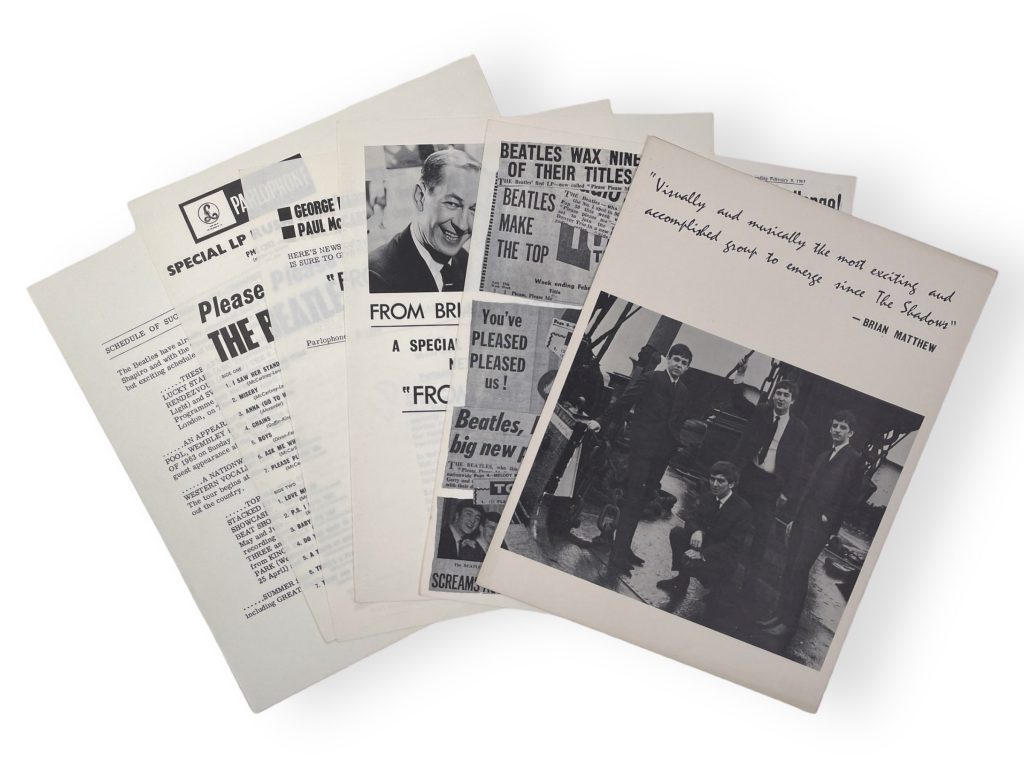
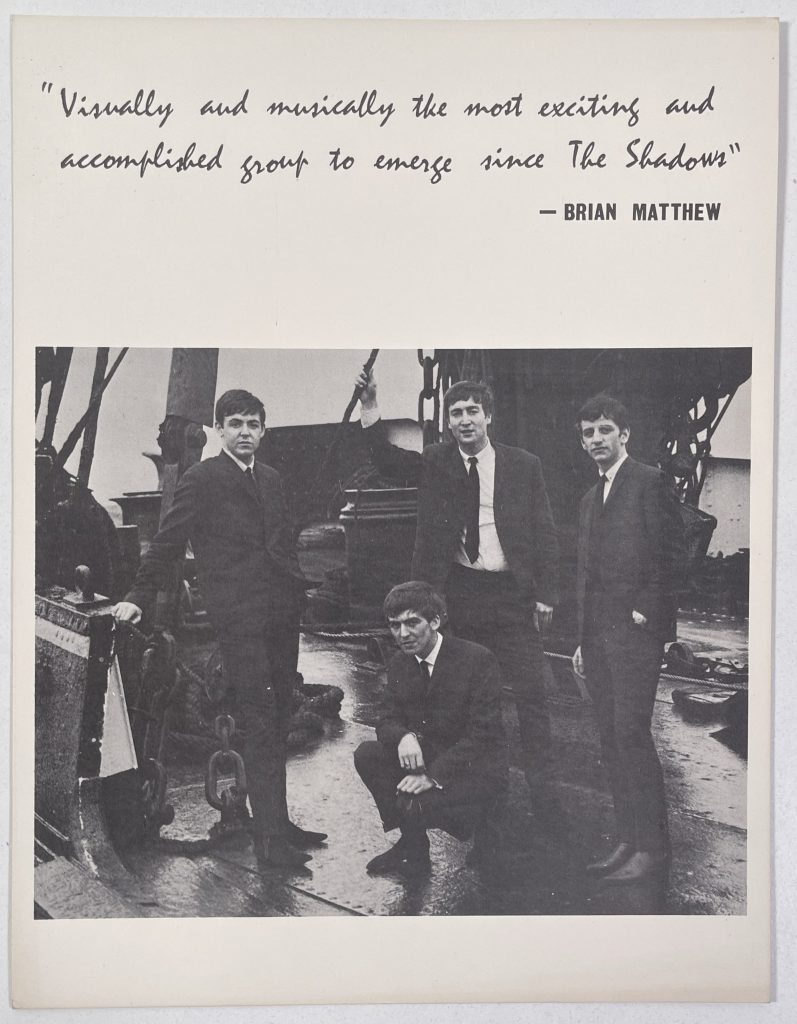
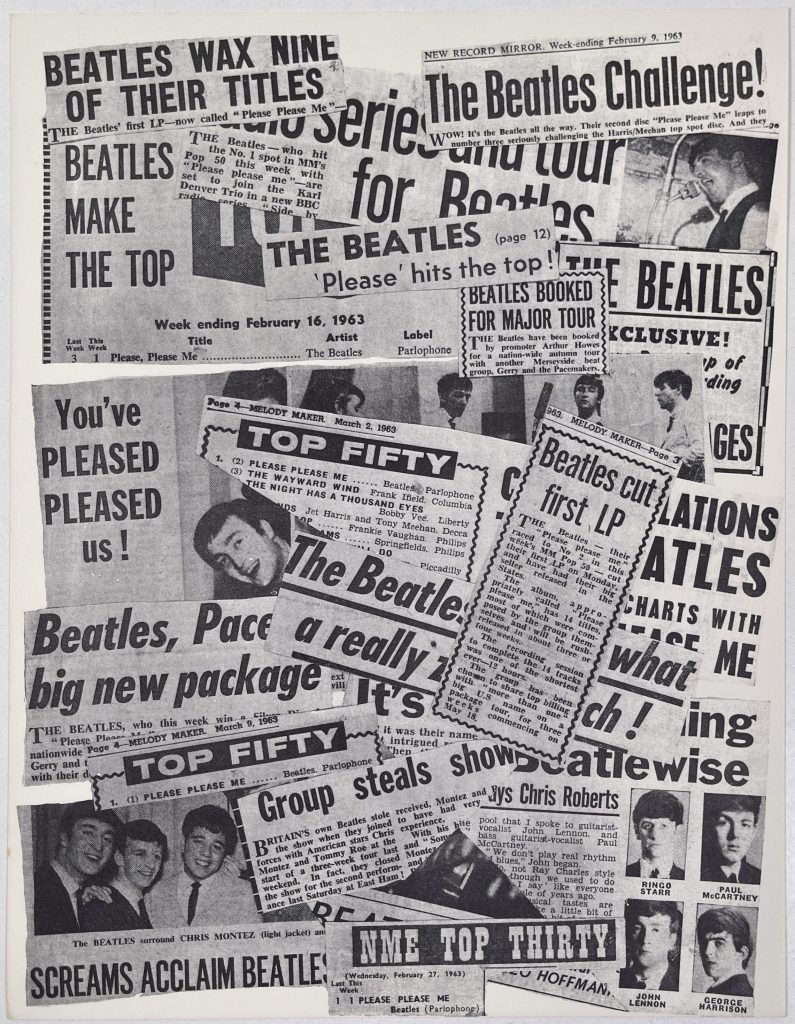
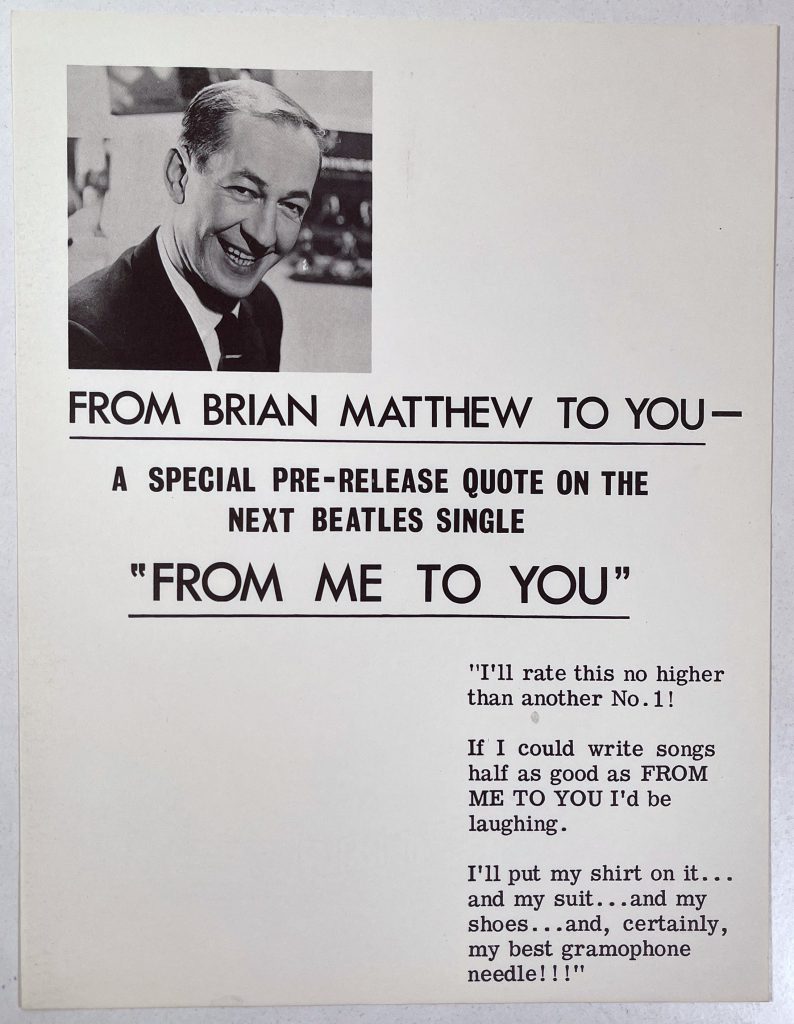
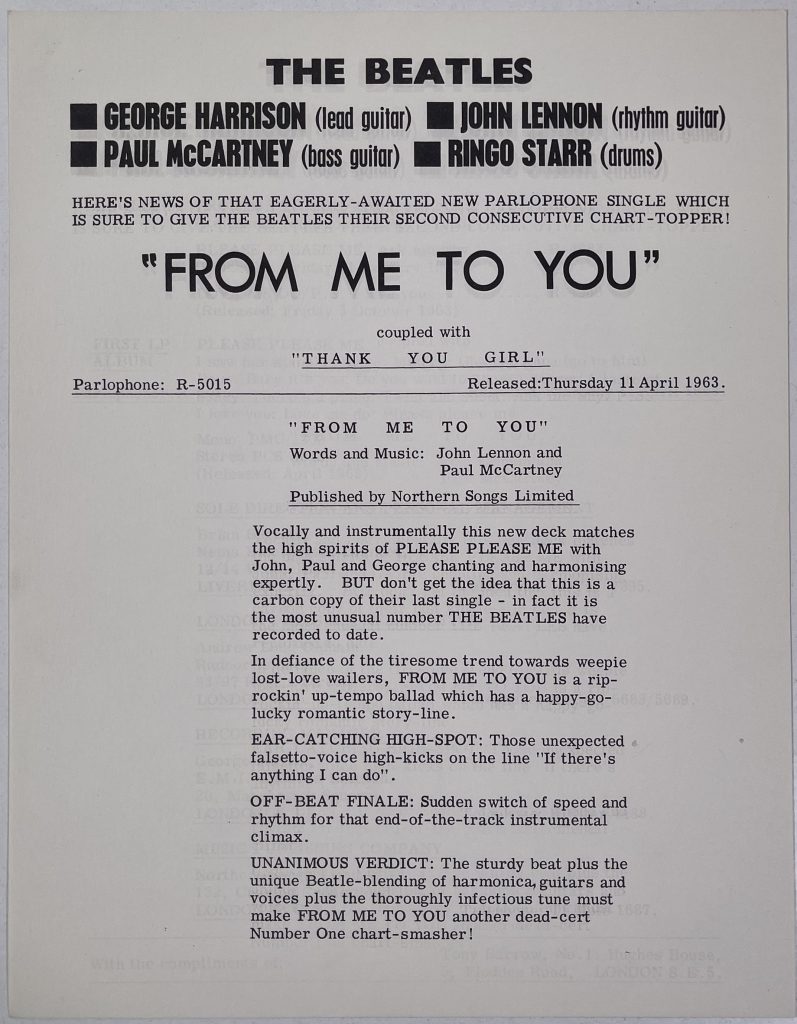
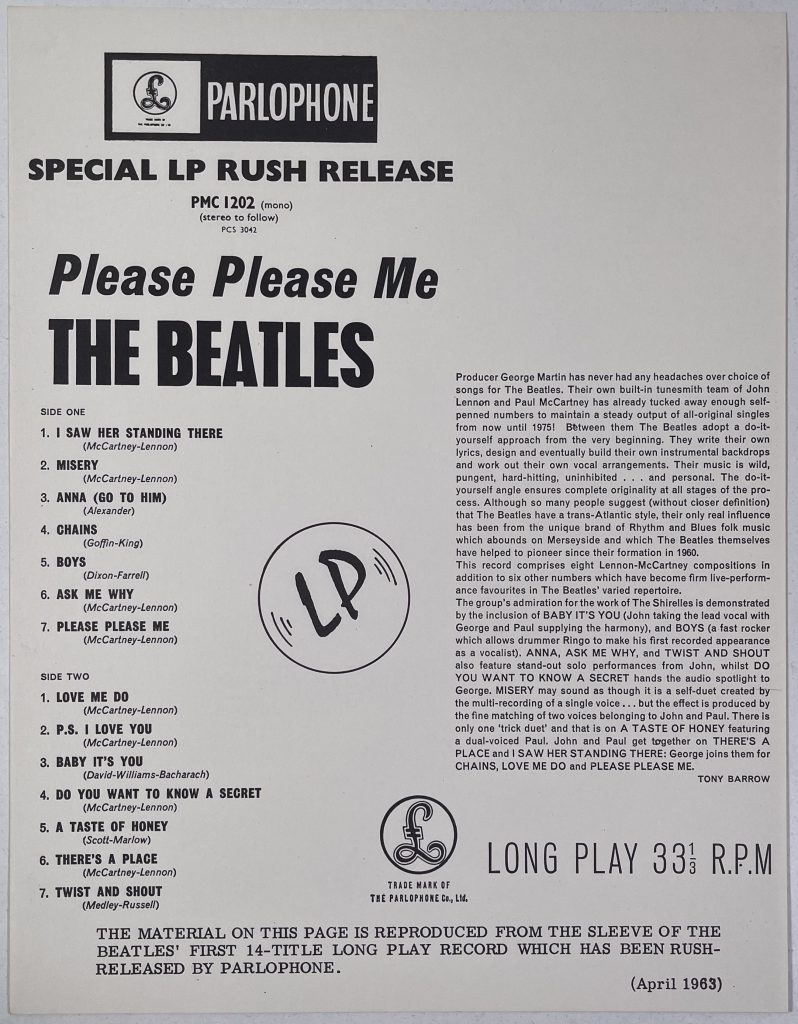
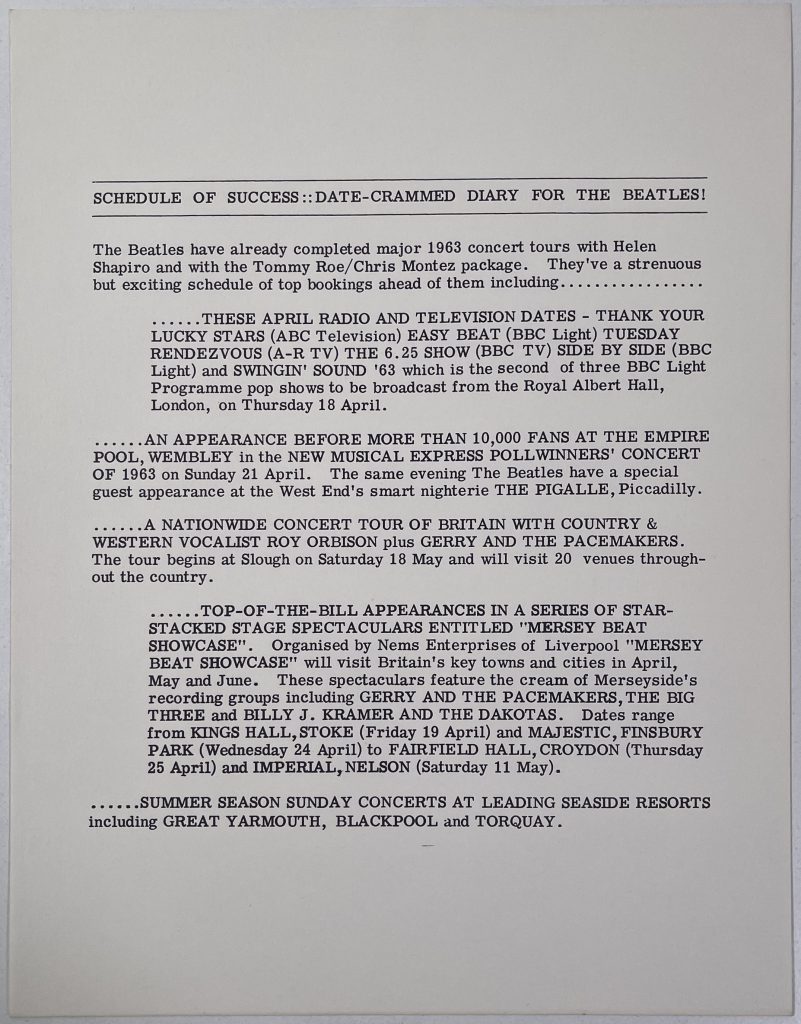
Last updated on September 19, 2023

Contribute!
Have you spotted an error on the page? Do you want to suggest new content? Or do you simply want to leave a comment ? Please use the form below!